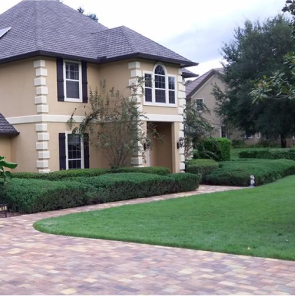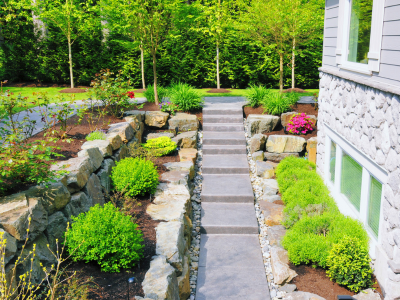Landscape design, often regarded as the art of shaping outdoor spaces, holds the power to transform your surroundings into captivating havens of natural beauty and functionality. Whether you have a sprawling garden or a cozy backyard, understanding the fundamental principles of landscape design is the key to crafting an environment that not only pleases the eye but also serves a purpose.
In this guide, we delve into the core principles of landscape design, unraveling the secrets behind breathtaking outdoor aesthetics. Whether you’re a gardening enthusiast or a homeowner looking to revamp your space, let’s embark on a journey through the essential principles that will elevate your landscape design game.
Principle 1: Unity and Harmony
Landscape design emphasizes unity and harmony, likening it to a conductor orchestrating elements into a visually pleasing composition, forming the foundation for all other features.
Unity: Creating a Cohesive Whole
Unity in landscape design involves integrating all elements of your outdoor space, from plants to colors, textures, and hardscapes, to create a harmonious, integrated garden. Here are some tips for creating unity:
- Consistent Themes: Select a theme or style for your landscape and stick to it. Whether it’s formal, informal, contemporary, or cottage, a consistent theme creates visual cohesion.
- Repetition: Repeating certain elements, such as plant species or design motifs, helps tie the space together.
- Color Coordination: Harmonize plant and hardscape colors to create a unified color palette.
- Transitions: Use smooth transitions between different zones or areas in your landscape, avoiding abrupt shifts in design.
Harmony: Balancing Diversity
Harmony, a blend of unity and diversity, enables the harmonious arrangement of elements, enhancing the overall aesthetic through variations in color, texture, height, and form. Here are some tips for achieving harmony
- Plant Selection: Mix a variety of plants with diverse characteristics, making sure they coexist harmoniously in terms of growth habits and maintenance needs.
- Contrast and Balance: Use contrasting elements to create interest, but maintain a sense of balance to prevent visual chaos.
- Transitions: Gradually transition between different plant types or features to avoid sudden shifts in the landscape’s visual rhythm.

Principle 2: Balance
Balance is a fundamental principle of landscape design that brings a sense of equilibrium and stability to your outdoor space. Just as in life, balance in landscaping is about finding the right proportions and distribution of elements to create visual harmony.
There are two types of balance
- Symmetrical Balance: Achieved when elements on one side of a central point mirror those on the other. It imparts a formal and classical feel to a landscape.
- Asymmetrical Balance: Involves the distribution of different elements in a way that maintains equilibrium without mirroring each other exactly. This creates a more relaxed and informal atmosphere.
Balancing elements like plants, hardscapes, and focal points is crucial for creating an inviting, well-composed landscape, ensuring a visually pleasing and comfortable outdoor space.
Principle 3: Focal Point
A well-designed landscape captivates the eye by directing attention to a strategically placed focal point. In landscape design, a focal point serves as the centerpiece or visual anchor that draws observers in and adds depth and interest to the overall composition.
Focal points can take many forms, such as a stunning sculpture, a vibrant flower bed, a cascading waterfall, or even a carefully positioned seating area. The key is to create a strong visual element that stands out amidst the landscape’s backdrop.
Principle 4: Scale and Proportion
Scale and proportion are essential principles in landscape design, governing the size and relationships of elements within your outdoor space. Achieving the right balance between these two factors ensures a visually pleasing and harmonious environment.
Scale refers to the size of individual elements and their relationship to each other and the surrounding space. For instance, a massive tree in a small garden may overwhelm the area, while tiny plants in a large open space may seem insignificant.
Proportion, on the other hand, relates to how different elements harmonize with each other in terms of size. It involves ensuring that various elements, like plants, hardscapes, and structures, are in proportion to one another, creating a cohesive and balanced composition.
Principle 5: Rhythm and Repetition
Creating a sense of movement and flow within your landscape is accomplished through the principles of rhythm and repetition. These design elements engage the eye, create visual interest, and establish a pleasing rhythm in your outdoor space.
Rhythm in landscaping refers to the visual patterns and sequences that guide the observer’s eye through the environment. Just as in music, a well-designed landscape features variations in shape, color, and texture that lead the viewer along a predetermined path or sequence.
Repetition, on the other hand, involves the deliberate use of the same elements or motifs at regular intervals throughout the landscape. This repetition can occur with plants, hardscapes, or decorative elements, adding a sense of unity and coherence to the design.
Principle 6: Contrast and Variety
In landscape design, contrast and variety serve as dynamic tools to add interest, excitement, and depth to your outdoor space. These principles transform an ordinary garden into an extraordinary one by engaging the senses and creating a visual tapestry that captures attention.
Contrast involves the juxtaposition of elements with noticeable differences. This can include contrasting colors, textures, shapes, or sizes. For instance, pairing dark foliage with vibrant flowers or smooth river stones with rough-hewn wooden benches creates striking visual contrasts that are visually appealing.
Variety, on the other hand, introduces diversity into your landscape. It means incorporating a wide range of elements, such as different plant species, hardscape materials, and design features. This variety adds depth and richness to your outdoor environment, preventing monotony and fostering a sense of exploration.
Principle 7: Simplicity
The principle of simplicity in landscape design emphasizes the importance of understated elegance and functional clarity in creating a serene, uncluttered environment, promoting a serene and uncluttered environment. Here’s how simplicity can enhance your landscape:
- Clear Pathways: Ensure easy navigation with well-defined pathways and walkways, avoiding unnecessary twists and turns.
- Minimal Plant Selection: Choose a select number of plant species that thrive in your climate and suit your aesthetic preferences. Avoid overcrowding with too many varieties.
- Functional Design: Emphasize the functionality of your outdoor space. Prioritize features that align with your needs, such as seating areas, play spaces, or entertainment zones.
- Sustainable Practices: Simplify maintenance by opting for low-maintenance plants and sustainable landscaping practices.

Principle 8: Functionality
A well-designed landscape is not just about aesthetics; it also focuses on functionality, serving a purpose and enhancing lifestyle, transforming the landscape into an extension of your home.
Here’s how functionality plays a pivotal role in landscape design:
- Outdoor Living Areas: Design comfortable and inviting spaces for relaxation, dining, or social gatherings. Incorporate features like patios, decks, or pergolas to extend your living space outdoors.
- Paths and Walkways: Ensure easy and safe navigation throughout your landscape with well-planned paths and walkways. These functional elements connect various areas of your garden and enhance accessibility.
- Play and Recreation: If you have children or enjoy outdoor activities, consider including play areas, sports courts, or spaces for hobbies and games.
- Gardening Zones: Designate areas for gardening, whether it’s for vegetables, flowers, or herbs. Make sure these areas are easily accessible and well-suited for cultivation.
- Storage and Utility Spaces: Integrate practical features like storage sheds, compost bins, or rainwater harvesting systems to enhance the functionality of your landscape.
Principle 9: Sustainability
Sustainable landscaping is gaining prominence as environmental consciousness increases, promoting responsible and forward-thinking landscape design that benefits both the environment and homeowners. Here’s how the principle of sustainability is transforming landscape design:
- Native Plant Selection: Choose native plants that are adapted to your region’s climate and require less water and maintenance. Native plants also support local wildlife.
- Water Conservation: Implement efficient irrigation systems, such as drip irrigation or rainwater harvesting, to reduce water consumption. Xeriscaping, which focuses on drought-tolerant plants, is a sustainable landscaping approach.
- Soil Health: Prioritize soil health through practices like composting and mulching, improving soil structure and fertility. Healthy soil promotes plant growth and reduces the need for chemical fertilizers.
- Reduced Chemical Use: Minimize the use of pesticides and herbicides, opting for natural and organic alternatives to maintain a healthy ecosystem within your landscape.
- Wildlife-Friendly Features: Create habitats for birds, bees, and other beneficial wildlife with features like birdhouses, butterfly gardens, and pollinator-friendly plants.
- Recycled Materials: Use recycled and reclaimed materials for hardscapes, such as pathways and garden structures, to reduce waste and environmental impact.
- Maintenance Practices: Choose low-maintenance landscaping elements to minimize the need for constant upkeep, saving time and resources.
Principle 10: Maintenance
Maintaining your landscape is crucial for its beauty and functionality, ensuring it remains a source of joy and continues to thrive over time. Here’s why maintenance is a fundamental aspect of landscape design:
- Health and Growth: Regular maintenance, including pruning, fertilizing, and watering, promotes the health and growth of your plants. It prevents overgrowth and ensures they remain vibrant and disease-free.
- Weed and Pest Control: Addressing weeds and pests promptly prevents them from damaging your landscape. Regular inspections and appropriate treatments help maintain a pest-free environment.
- Seasonal Adjustments: Adjust your landscape to suit the changing seasons. This might involve planting seasonal flowers, protecting sensitive plants in winter, or adjusting irrigation schedules in summer.
- Hardscape Care: Maintain the integrity of hardscape elements, such as pathways, decks, and fences, through regular cleaning, repairs, and sealing to extend their lifespan.
- Pruning and Shaping: Prune trees and shrubs as needed to maintain their shape and prevent overcrowding. This also enhances safety by removing dead or hazardous branches.
Conclusion
In conclusion, mastering the ten essential principles of landscape design can transform your outdoor space into a harmonious, functional, and sustainable haven of natural beauty. Whether you’re seeking unity, balance, or sustainability, these principles guide you in creating a landscape that suits your lifestyle and aesthetic preferences. Remember, the journey to an exquisite outdoor oasis begins with a single step. If you’re ready to elevate your landscape, contact us today to explore how our expertise can bring your vision to life. Your dream garden is just a click away!